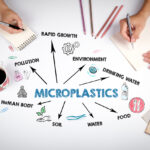New research connects microplastics in blood clots to higher heart attack and stroke risk
 (NaturalHealth365) Recent reports of microplastics discovered in male reproductive organs have sparked widespread discussion on social media. While the medical community is still uncertain about the long-term effects on human offspring, the increasing exposure to plastics raises alarm bells among researchers and the public alike.
(NaturalHealth365) Recent reports of microplastics discovered in male reproductive organs have sparked widespread discussion on social media. While the medical community is still uncertain about the long-term effects on human offspring, the increasing exposure to plastics raises alarm bells among researchers and the public alike.
The concern doesn’t stop there. A new study published in eBioMedicine has uncovered a troubling link between microplastics in blood clots and serious health issues, including strokes and heart attacks.
Microplastics: An unwelcome guest in our bloodstream
Researchers conducted an in-depth study to better understand the impact of microplastic pollution on human health. They examined blood clots from patients who had experienced strokes, deep vein thrombosis, or heart attacks, using advanced spectrometry techniques to identify and measure various types of microplastic particles.
The findings were striking: 80% of the analyzed blood clots contained microplastics. More concerning still, the study suggested a correlation between higher concentrations of microplastics and an increased risk of thrombotic events and more severe health outcomes.
The study results reveal microplastics consisting of polymers with surprisingly diverse physical characteristics were found in varying concentrations within the thrombi of veins and arteries. Though a small amount of microplastics within thrombi might not be problematic, their accumulation is linked to ischemic strokes.
The bigger picture: Microplastics and environmental health
While the focus on human health is crucial, it’s important to consider the wider environmental impact of microplastics. These tiny particles aren’t just a problem for our bodies; they’re infiltrating ecosystems worldwide, from the depths of our oceans to the soil beneath our feet. This is where the problem begins.
Microplastics have been found in marine animals ranging from tiny plankton to large whales. Fish and seabirds often mistake these particles for food, leading to malnutrition and potential toxic effects. This contamination doesn’t just affect marine life – it also poses risks to humans who consume seafood.
Recent studies have shown that microplastics are accumulating in agricultural soils, potentially affecting crop growth and soil health. This contamination can occur through various routes, including the use of plastic mulch in farming and the application of sewage sludge as fertilizer.
But microplastics aren’t just in our water and food – they’re in the air, too. Urban areas, in particular, have shown high concentrations of airborne microplastics, which can be inhaled and potentially cause respiratory issues.
Practical steps to reducing your exposure
While it’s nearly impossible to avoid microplastics entirely, there are ways to minimize your exposure:
- Limit the use of plastic packaging, especially for food storage.
- Avoid heating food in plastic containers.
- Choose glass or stainless steel water bottles over plastic ones.
- Be aware that certain foods, like honey, salt, beer, and fish, may contain higher levels of microplastics.
- Opt for products in glass or paper packaging when possible.
- Use reusable cloth bags instead of plastic for shopping.
As awareness of the microplastic problem grows, so does the need for further research and policy action. Scientists are calling for more comprehensive studies to understand the long-term health effects of microplastic exposure and to develop effective strategies for reducing pollution. Policymakers are also beginning to take notice, with several countries implementing bans on single-use plastics and growing calls for stricter regulations on plastic production and disposal.
Everything from milk jugs to plastic bottles, plastic shopping bags, and even some toiletries are likely to contain high levels of microplastics. Scrapping plastic bags for paper or a tote bag and always choosing glass bottles over plastic can help minimize exposure to microplastics.
By making these small changes in our daily lives, we can reduce our exposure to microplastics and potentially mitigate their impact on our health. As research continues, staying informed and making conscious choices will be key in navigating this significant health concern.
Editor’s note: Discover the best strategies to avoid a heart attack or stroke, own the Cardiovascular Docu-Class created by NaturalHealth365 Programs.
Sources for this article include:



